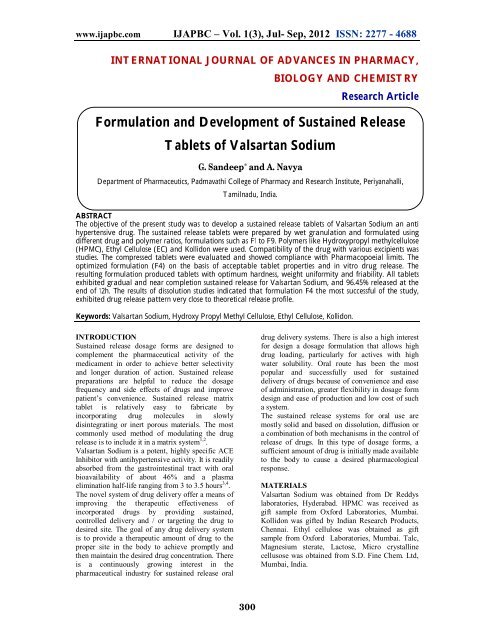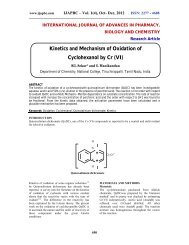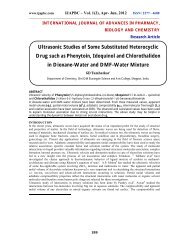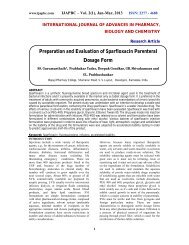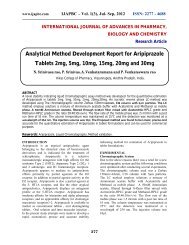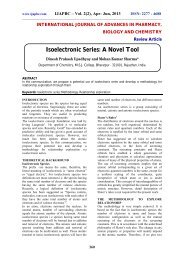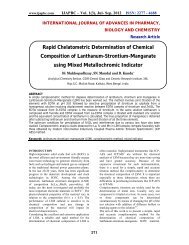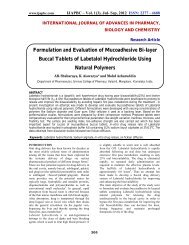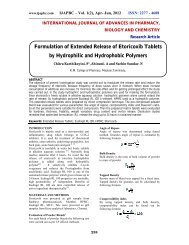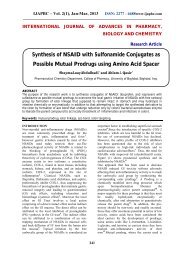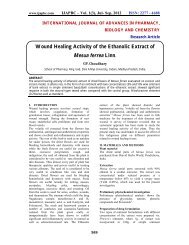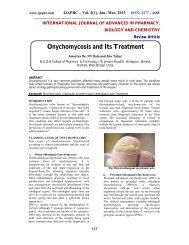Formulation and Development of Sustained Release Tablets ... - ijapbc
Formulation and Development of Sustained Release Tablets ... - ijapbc
Formulation and Development of Sustained Release Tablets ... - ijapbc
You also want an ePaper? Increase the reach of your titles
YUMPU automatically turns print PDFs into web optimized ePapers that Google loves.
www.<strong>ijapbc</strong>.com IJAPBC – Vol. 1(3), Jul- Sep, 2012 ISSN: 2277 - 4688<br />
INTERNATIONAL JOURNAL OF ADVANCES IN PHARMACY,<br />
BIOLOGY AND CHEMISTRY<br />
Research Article<br />
<strong>Formulation</strong> <strong>and</strong> <strong>Development</strong> <strong>of</strong> <strong>Sustained</strong> <strong>Release</strong><br />
<strong>Tablets</strong> <strong>of</strong> Valsartan Sodium<br />
G. S<strong>and</strong>eep * <strong>and</strong> A. Navya<br />
Department <strong>of</strong> Pharmaceutics, Padmavathi College <strong>of</strong> Pharmacy <strong>and</strong> Research Institute, Periyanahalli,<br />
Tamilnadu, India.<br />
ABSTRACT<br />
The objective <strong>of</strong> the present study was to develop a sustained release tablets <strong>of</strong> Valsartan Sodium an anti<br />
hypertensive drug. The sustained release tablets were prepared by wet granulation <strong>and</strong> formulated using<br />
different drug <strong>and</strong> polymer ratios, formulations such as F1 to F9. Polymers like Hydroxypropyl methylcellulose<br />
(HPMC), Ethyl Cellulose (EC) <strong>and</strong> Kollidon were used. Compatibility <strong>of</strong> the drug with various excipients was<br />
studies. The compressed tablets were evaluated <strong>and</strong> showed compliance with Pharmacopoeial limits. The<br />
optimized formulation (F4) on the basis <strong>of</strong> acceptable tablet properties <strong>and</strong> in vitro drug release. The<br />
resulting formulation produced tablets with optimum hardness, weight uniformity <strong>and</strong> friability. All tablets<br />
exhibited gradual <strong>and</strong> near completion sustained release for Valsartan Sodium, <strong>and</strong> 96.45% released at the<br />
end <strong>of</strong> 12h. The results <strong>of</strong> dissolution studies indicated that formulation F4 the most successful <strong>of</strong> the study,<br />
exhibited drug release pattern very close to theoretical release pr<strong>of</strong>ile.<br />
Keywords: Valsartan Sodium, Hydroxy Propyl Methyl Cellulose, Ethyl Cellulose, Kollidon.<br />
INTRODUCTION<br />
<strong>Sustained</strong> release dosage forms are designed to<br />
complement the pharmaceutical activity <strong>of</strong> the<br />
medicament in order to achieve better selectivity<br />
<strong>and</strong> longer duration <strong>of</strong> action. <strong>Sustained</strong> release<br />
preparations are helpful to reduce the dosage<br />
frequency <strong>and</strong> side effects <strong>of</strong> drugs <strong>and</strong> improve<br />
patient’s convenience. <strong>Sustained</strong> release matrix<br />
tablet is relatively easy to fabricate by<br />
incorporating drug molecules in slowly<br />
disintegrating or inert porous materials. The most<br />
commonly used method <strong>of</strong> modulating the drug<br />
release is to include it in a matrix system 1,2 .<br />
Valsartan Sodium is a potent, highly specific ACE<br />
Inhibitor with antihypertensive activity. It is readily<br />
absorbed from the gastrointestinal tract with oral<br />
bioavailability <strong>of</strong> about 46% <strong>and</strong> a plasma<br />
elimination half-life ranging from 3 to 3.5 hours 3,4 .<br />
The novel system <strong>of</strong> drug delivery <strong>of</strong>fer a means <strong>of</strong><br />
improving the therapeutic effectiveness <strong>of</strong><br />
incorporated drugs by providing sustained,<br />
controlled delivery <strong>and</strong> / or targeting the drug to<br />
desired site. The goal <strong>of</strong> any drug delivery system<br />
is to provide a therapeutic amount <strong>of</strong> drug to the<br />
proper site in the body to achieve promptly <strong>and</strong><br />
then maintain the desired drug concentration. There<br />
is a continuously growing interest in the<br />
pharmaceutical industry for sustained release oral<br />
drug delivery systems. There is also a high interest<br />
for design a dosage formulation that allows high<br />
drug loading, particularly for actives with high<br />
water solubility. Oral route has been the most<br />
popular <strong>and</strong> successfully used for sustained<br />
delivery <strong>of</strong> drugs because <strong>of</strong> convenience <strong>and</strong> ease<br />
<strong>of</strong> administration, greater flexibility in dosage form<br />
design <strong>and</strong> ease <strong>of</strong> production <strong>and</strong> low cost <strong>of</strong> such<br />
a system.<br />
The sustained release systems for oral use are<br />
mostly solid <strong>and</strong> based on dissolution, diffusion or<br />
a combination <strong>of</strong> both mechanisms in the control <strong>of</strong><br />
release <strong>of</strong> drugs. In this type <strong>of</strong> dosage forms, a<br />
sufficient amount <strong>of</strong> drug is initially made available<br />
to the body to cause a desired pharmacological<br />
response.<br />
MATERIALS<br />
Valsartan Sodium was obtained from Dr Reddys<br />
laboratories, Hyderabad. HPMC was received as<br />
gift sample from Oxford Laboratories, Mumbai.<br />
Kollidon was gifted by Indian Research Products,<br />
Chennai. Ethyl cellulose was obtained as gift<br />
sample from Oxford Laboratories, Mumbai. Talc,<br />
Magnesium sterate, Lactose, Micro crystalline<br />
cellusose was obtained from S.D. Fine Chem. Ltd,<br />
Mumbai, India.<br />
300
www.<strong>ijapbc</strong>.com IJAPBC – Vol. 1(3), Jul- Sep, 2012 ISSN: 2277 - 4688<br />
Preparation <strong>and</strong> Characterization <strong>of</strong> Granules<br />
The granules were prepared by wet granulation<br />
method <strong>and</strong> were evaluated for their bulk density,<br />
tapped density, compressibility index, angle <strong>of</strong><br />
repose <strong>and</strong> Hausner ratio.<br />
Compressibility index = [ t - b / t ] × 100<br />
Hausner ratio = t / b<br />
Where t = tapped density<br />
b = initial bulk density <strong>of</strong> tablet blend.<br />
Angle <strong>of</strong> repose <strong>of</strong> tablet blend measures the<br />
resistance to particle flow <strong>and</strong> was determined by<br />
fixed funnel method 5 .<br />
<strong>Formulation</strong> <strong>of</strong> <strong>Sustained</strong> <strong>Release</strong> <strong>Tablets</strong><br />
After evaluation <strong>of</strong> granules the sustained release<br />
matrix tablets were formulated by compressing the<br />
granules. The tablets were formulated such that<br />
each tablet contains 50 mg <strong>of</strong> Valsartan Sodium<br />
<strong>and</strong> total weight <strong>of</strong> 350 mg, containing 20% (w/w)<br />
<strong>of</strong> the drug.<br />
Compatibility Testing <strong>of</strong> Drug with Polymer<br />
Fourier Transforms Infra-Red (FTIR)<br />
Spectroscopy<br />
FTIR study was carried out to check compatibility<br />
<strong>of</strong> drug with polymers. Infrared spectrum <strong>of</strong><br />
Valsartan Sodium <strong>and</strong> other Polymers was<br />
determined on fourier transform infrared<br />
spectrophotometer using KBr dispersion method 6 .<br />
Evaluation <strong>of</strong> <strong>Sustained</strong> <strong>Release</strong> <strong>Tablets</strong><br />
The prepared sustained release tablets were<br />
evaluated for uniformity <strong>of</strong> weight hardness <strong>and</strong><br />
friability 7,8 .<br />
In-Vitro Dissolution Studies<br />
The in vitro dissolution was carried out using USP<br />
Dissolution testing apparatus type-II. The tablets<br />
were placed in pH 6.8 phosphate buffers for next<br />
12 hours, then the apparatus was run at 37ºC ±<br />
0.5ºC <strong>and</strong> a rotating speed <strong>of</strong> 50 rpm in a 900 ml<br />
dissolution medium. The 5 ml aliquots were<br />
withdrawn at intervals <strong>of</strong> 0.5, 1, 1.5, 2, 3, 4, 5, 6, 7,<br />
8, 9, 10 hours <strong>and</strong> replacement was done each time<br />
with equal amounts <strong>of</strong> fresh dissolution medium<br />
maintained at same temperature. Each 5 ml aliquot<br />
was filtered through Whatman filter paper (No. 41).<br />
5 ml <strong>of</strong> sample with pH 6.8 phosphate buffers for<br />
12 hours <strong>and</strong> absorbance was measured at 205.5<br />
nm using a Shimadzu-1700 UV<br />
spectrophotometer 9 .<br />
Table 1: Composition <strong>of</strong> Valsartan Sodium SR matrix tablet<br />
Ingredients F1 F2 F3 F4 F5 F6 F7 F8 F9<br />
VS 160 160 160 160 160 160 160 160 160<br />
HPMC 40 80 120 - - - - - -<br />
KOLLIDON - - - 40 80 120 - - -<br />
EC - - - - - - 40 80 120<br />
PVP 8 8 8 8 8 8 8 8 8<br />
MCC 137.2 97.2 57.2 137.2 97.2 57.2 137.2 97.2 57.2<br />
MS 1.6 1.6 1.6 1.6 1.6 1.6 1.6 1.6 1.6<br />
TALC 3.2 3.2 3.2 3.2 3.2 3.2 3.2 3.2 3.2<br />
Total 350 350 350 350 350 350 350 350 350<br />
Table 2: Physico-chemical characterization <strong>of</strong> Valsartan<br />
Sodium SR matrix tablets<br />
F Code<br />
Thickness<br />
(mm)<br />
Hardness<br />
(kg/cm 2 )<br />
Friability<br />
(%)<br />
Weight<br />
variation (%)<br />
F1 3.22 5.50 0.36 119.8±1.48<br />
F2 3.37 5.50 0.39 120.4±0.54<br />
F3 3.14 5.58 0.12 118.6±0.41<br />
F4 3.20 5.66 0.41 118.8±1.64<br />
F5 3.08 4.25 0.54 120.6±1.14<br />
F6 3.33 4.08 0.58 119.2±0.83<br />
F7 3.13 4.12 0.34 117.2±0.12<br />
F8 3.21 5.42 0.46 118.9±0.23<br />
F9 3.25 5.31 0.51 119.3±0.39<br />
RESULTS AND DISCUSSION<br />
The prepared sustained release tablets were<br />
evaluated for thickness, weight variation, hardness,<br />
friability, drug content, in vitro drug dissolution<br />
studies <strong>and</strong> stability studies. The granules prepared<br />
for compression <strong>of</strong> sustained release tablets were<br />
301
www.<strong>ijapbc</strong>.com IJAPBC – Vol. 1(3), Jul- Sep, 2012 ISSN: 2277 - 4688<br />
evaluated for their flow properties. Angle <strong>of</strong> repose<br />
was in the range <strong>of</strong> 25.49 to 31.23 which indicates<br />
excellent flow <strong>of</strong> granules for all formulations. The<br />
bulk density <strong>of</strong> the granules was in the range <strong>of</strong><br />
0.214 to 0.362 g/ml, which indicates that the<br />
powder was not bulky. The Carr’s index was found<br />
to be in the range <strong>of</strong> 14.74 to 18.32, the Hausner’s<br />
ratio was found to be in the range <strong>of</strong> 1.17 to 1.19,<br />
indicating compressibility <strong>of</strong> the tablet blend is<br />
good. These values indicate that the prepared<br />
granules exhibited good flow properties.<br />
Compatibility Testing <strong>of</strong> Drug with Polymer<br />
Fourier Transforms Infra-Red (FTIR)<br />
Spectroscopy<br />
Major functional groups present in Valsartan<br />
Sodium show characteristic peaks in IR spectrum.<br />
Figure 1 shows peaks observed at different wave<br />
numbers <strong>and</strong> the functional group associated with<br />
these peaks for drug <strong>and</strong> drug with different<br />
polymer. The major peaks are identical to<br />
functional group <strong>of</strong> Valsartan Sodium. Hence, it<br />
was confirmed that there was no incompatibility<br />
between drug <strong>and</strong> various polymers.<br />
Graph 1: FTIR graph <strong>of</strong> valsartan sodium<br />
Graph 2: FTIR graph <strong>of</strong> valsartan sodium+HPMC<br />
302
www.<strong>ijapbc</strong>.com IJAPBC – Vol. 1(3), Jul- Sep, 2012 ISSN: 2277 - 4688<br />
Graph 3: FTIR graph <strong>of</strong> valsartan sodium+Kollidon<br />
Graph 4: FTIR graph <strong>of</strong> valsartan sodium+Ethyl Cellulose<br />
Evaluation <strong>of</strong> Valsartan Sodium sustained<br />
release tablets<br />
The Valsartan Sodium sustained release tablets<br />
were <strong>of</strong>f-white, smooth, <strong>and</strong> flat shaped in<br />
appearance. The results <strong>of</strong> physicochemical<br />
characterizations are shown in Table 2. The<br />
thickness <strong>of</strong> sustained release tablets was measured<br />
was ranged between 3.22 <strong>and</strong> 3.25 mm. The weight<br />
variation for different formulations (F1 to F9) was<br />
found to be 119.8±1.48% to 119.3±0.39%, showing<br />
satisfactory results as per Indian Pharmacopoeia<br />
(IP) limit. The hardness <strong>of</strong> the sustained release<br />
tablets was measured by Monsanto hardness tester<br />
<strong>and</strong> was controlled between 5.50 <strong>and</strong> 5.31. The<br />
friability was below 1% for all the formulations,<br />
which is an indication <strong>of</strong> good mechanical<br />
resistance <strong>of</strong> the tablet.<br />
In-Vitro dissolution studies<br />
In vitro dissolution studies <strong>of</strong> all the formulations<br />
<strong>of</strong> sustained release tablets <strong>of</strong> Valsartan Sodium<br />
were carried out in pH 6.8 phosphate buffers for 12<br />
hrs. The study was performed for 12 hours, <strong>and</strong><br />
percentage drug release was calculated at 1 hours<br />
time intervals. The results <strong>of</strong> in vitro dissolution<br />
studies <strong>of</strong> all formulations were shown in Figure 5.<br />
303
www.<strong>ijapbc</strong>.com IJAPBC – Vol. 1(3), Jul- Sep, 2012 ISSN: 2277 - 4688<br />
Graph. 5: Cumulative % Drug <strong>Release</strong> Vs Time (hrs)<br />
Stability study<br />
The stability study results obtained were shown in<br />
Table 4. The Valsartan Sodium sustained release<br />
tablets did not show any significant change in<br />
physicochemical parameters <strong>and</strong> other tests. Thus,<br />
it was found that the sustained release tablets <strong>of</strong><br />
Valsartan Sodium formulation (F4) were stable<br />
under these storage conditions for at least 3<br />
months 10 .<br />
CONCLUSION<br />
The aim <strong>of</strong> the study was to formulate SR tablets <strong>of</strong><br />
Valsartan Sodium various hydrophilic <strong>and</strong><br />
hydrophobic polymers on in vitro release rate from<br />
sustained release tablets <strong>of</strong> Valsartan Sodium.<br />
Different types <strong>of</strong> polymers like HPMC, Ethyl<br />
cellulose <strong>and</strong> Kollidon were studied. <strong>Formulation</strong><br />
F4 showed sustained drug release for 12 hours so it<br />
was selected as the best formulation among all the<br />
nine formulations. The Valsartan Sodium sustained<br />
release tablets were stable at 40ºC/75% RH up to 3<br />
months.<br />
REFERENCES<br />
1. Basak SC, Jayakumar RBM <strong>and</strong> Lucas<br />
MK, <strong>Formulation</strong> <strong>and</strong> release behavior <strong>of</strong><br />
sustained release Ambroxol hydrochloride<br />
HPMC matrix tablet, Indian Journal <strong>of</strong><br />
Pharmaceutical Sciences. 2006;<br />
68(5):594-597.<br />
2. D<strong>and</strong>agi PM, Mastiholimat VS, Patil MB,<br />
Manvi FV, Gagad AP, <strong>and</strong> Sharma R.<br />
<strong>Development</strong> <strong>and</strong> evaluation <strong>of</strong><br />
Theophylline <strong>and</strong> Salbutamol sulphate<br />
sustained release matrix tablets, Indian<br />
Journal <strong>of</strong> Pharmaceutical Sciences. 2005;<br />
67(5):598-602.<br />
3. Shruti C, Gayathri VP <strong>and</strong> Sanjay KM.<br />
<strong>Release</strong> modulating hydrophilic matrix<br />
systems <strong>of</strong> losartan potassium:<br />
Optimization <strong>of</strong> formulation using<br />
stastical experimental design, Science<br />
direct, 2006.<br />
4. Chopra S, Patil GV <strong>and</strong> Motwani SK.<br />
Response surface methodology for<br />
optimization <strong>of</strong> Losartan potassium<br />
controlled release tablets, Science direct.<br />
2006;1(5):15-19.<br />
5. Lachman L, Lieberman HA <strong>and</strong> Kanig JL.<br />
The theory <strong>and</strong> practice <strong>of</strong> industrial<br />
pharmacy. 3 rd edn., Varghese Publishing<br />
House, Mumbai, 1991;67-71:183-184,<br />
320.<br />
6. Aulton ME. Eds, Pharmaceutics: The<br />
science <strong>of</strong> dosage form design, 2 nd edn.,<br />
Churchill Livingstone, New York,<br />
2002;487-488:492-495.<br />
7. Anonymous, The Indian Pharmacopoeia.<br />
Volume- I, II, III. The Controller <strong>of</strong><br />
publication, New Delhi, 2007;1319-1320.<br />
8. Banker, G.S. <strong>and</strong> Rhodes, C.T. Eds.<br />
Modern Pharmaceutics. 3 rd edn., Marcel<br />
Dekker, Inc. New York, 1996, 668-669.<br />
9. Yeole PG, Galgatte UC, Babla IB <strong>and</strong><br />
Nakhat PD. Design <strong>and</strong> evaluation <strong>of</strong><br />
Xanthan gum-based sustained release<br />
matrix tablets <strong>of</strong> Dicl<strong>of</strong>enac Sodium,<br />
Indian Journal <strong>of</strong> Pharmaceutical<br />
Sciences. 2006;185-189.<br />
10. Manavatan R <strong>and</strong> Ramasamy S. Physical<br />
Pharmaceutics, 1 st edn. Vignesh Publisher,<br />
Chennai. 1995;288-299.<br />
304


